In 2024, the Unified Payments Interface (UPI) revolutionized the digital payment landscape 📳 in India, facilitating seamless and instant fund transfers. According to the National Payments Corporation of India (NPCI), UPI transactions reached a staggering value of ₹19,64,464.52 crore in April, underscoring its widespread adoption and efficiency. At the core of UPI's success is the robust Application Programming Interface (API) framework, which enables internet banking systems and applications to interact flawlessly.

This sudden rise in UPI usage has been accompanied by a surge in fraudulent activities. The Union Finance Ministry of India informed the Parliament that over 95,000 fraud cases involving UPI transactions were recorded in 2022 - 23, marking an increase from 77,000 cases in 2020 - 21 and 84,000 cases in 2021 - 22. This alarming trend highlights the critical need for comprehensive API testing and enhanced security measures to protect users.
As UPI continues to evolve, testing its security and functionality remains vital to sustaining its growth and reliability in the digital payments ecosystem 🌳. Let's look at the some of the fundamental features of this landscape and try to
▶️ Understand the Importance of Testing.
▶️ A brief on the integration of API Testing in UPI and the Top 5 Tools for Testing.
▶️ Listing the Positive and Negative Scenarios.
▶️ Implementing Best Practices for Secure Finance
▶️ Analyze UPI's Impact on Modern Payment Systems.
▶️ Compare UPI Payment with Digital Currency while Navigating Through the Various Phases in the Evaluation of the former.
▶️ Unveil the Future Landscape of UPI API Testing
▶️ Common Pitfalls in UPI Testing
Importance of Testing UPI Payment Systems
Ensuring the security of UPI transactions is of the utmost importance, both internally and externally. Externally, measures must be taken to combat human errors, such as entering incorrect security pins or exhausting UPI payment limit. Internally, unseen errors pose a threat, making it imperative to secure 🔒 the source code from cyberattacks. API testing plays a pivotal role in allowing organizations to fortify their defenses and ensure the integrity of their systems against potential threats.
The security of the source code is intricately linked with API security. APIs serve as the bridge 🌉 between the source code and external systems, making them a prime target for unethical groups. By thoroughly testing APIs, organizations can identify and rectify vulnerabilities in the source code, thereby enhancing overall system security.
However, API testing for UPI payment systems encompasses more than just security testing. It also involves validating functionality to ensure the API performs as expected, performance testing to handle various loads and transaction volumes, and resilience testing to maintain service continuity under different scenarios. Tools like Postman, SoapUI, JMeter, Selenium, and K6 are essential for these comprehensive tests. By addressing all these aspects, organizations can ensure the reliability, security, and efficiency of their UPI payment systems.
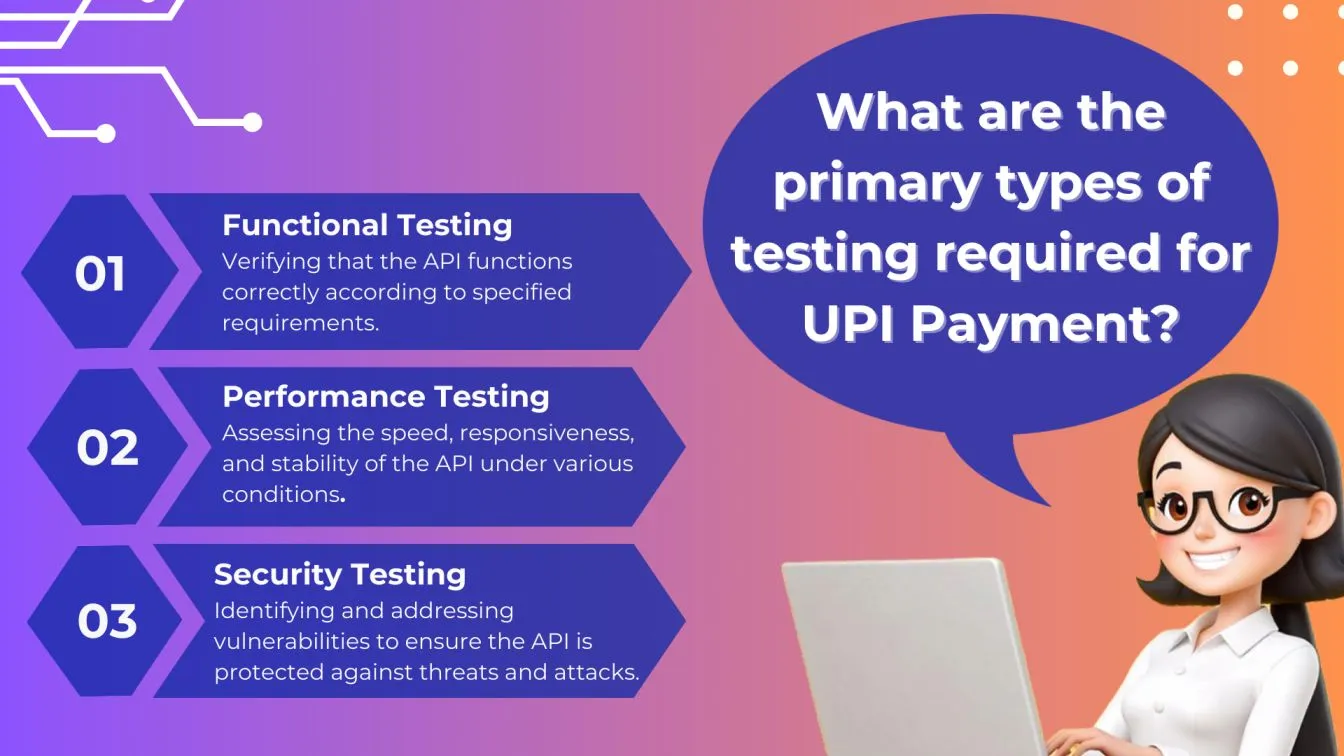
However, testing UPI is ineffective if the underlying API has defects. Regardless of the precautions taken by banks, data integrity can be compromised if the API framework is flawed. This underscores the critical need for thorough API testing in UPI payment system integration.
Why is API testing important for UPI Payment system integration?
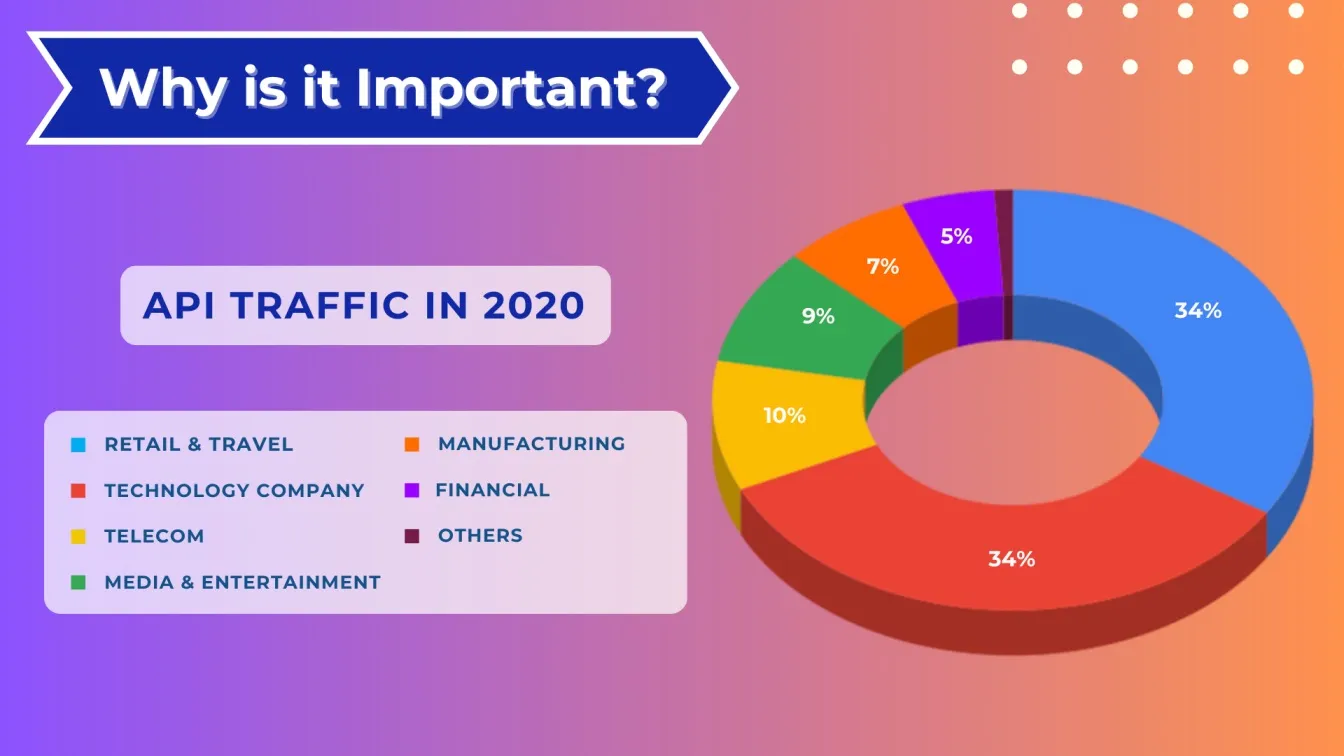
API is vital for multi platform validation while maintaining a high level of security on user details. With new tech like multi-factor authentication and blockchain, organizations offer protection from Potential Frauds ⭐.
Organizations ensure compatibility with various platforms and provide users with a seamless experience. API testing helps identify and address usability issues which ensure that users can navigate the process efficiently. Successful payment requests are crucial for fostering trust and confidence among users which ultimately enhance the overall experience.
Furthermore, API testing enables organizations to analyze transactions and identify any discrepancies or errors promptly. Comprehensive testing organizations can reduce risks and safeguard sensitive data. Overall, API testing is essential for ensuring the reliability, security and efficiency of UPI integration process.

Top 5 tools are commonly used for testing UPI payment system APIs
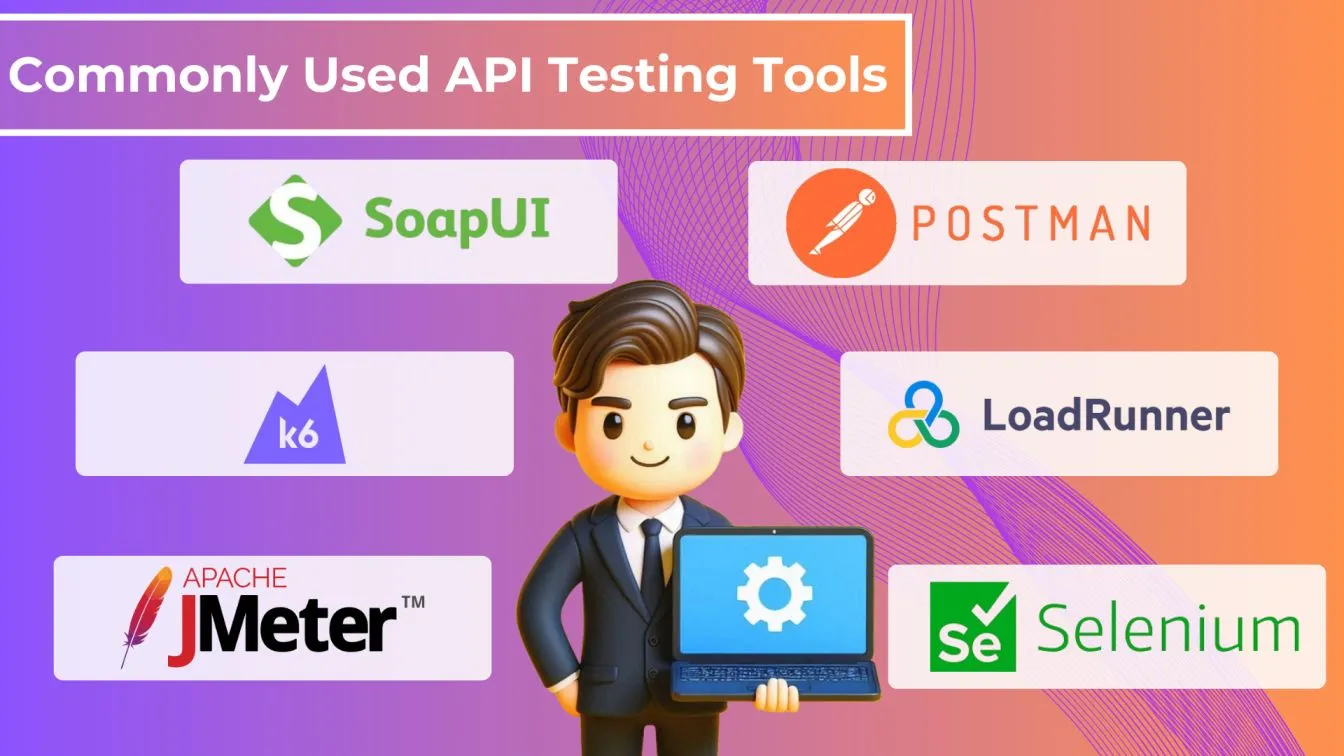
API testing is a familiar concept for many testers and fortunately, numerous tools have been developed specifically for this purpose, aiding organizations in conducting faster and more optimized testing.
🪛 Postman: Postman is a widely used API testing tool that allows testers to create, manage and execute API requests. It provides a user-friendly interface for designing and automating tests, making it ideal for testing UPI system APIs.
🪛 SoapUI: A popular tool for testing API. It offers comprehensive testing capabilities, including functional testing, load testing, integration testing and security testing.
🪛 JMeter: Apache JMeter is a powerful open-source tool for performance testing, including testing the performance of APIs under different volumes 🔊 of transactions. It can simulate high loads and analyze performance metrics, helping organizations identify and address performance issues.
🪛 Selenium: Selenium is primarily known as a web automation tool, but it can also be used for API testing. It provides capabilities for automating browser interactions and making HTTP requests which show an immense potential in testing web-based UPI using APIs.
🪛 K6: A developer-friendly load testing tool, utilizing JavaScript for performance tests. It's scalable, simulating thousands of concurrent users, ideal for assessing API scalability and reliability under heavy loads 🏋️.
🪛 LoadRunner: LoadRunner is a performance testing tool developed by Micro Focus. It's used to test the performance, scalability and reliability of web and mobile applications.
These tools not only facilitate the detection of fraudulent activities and implementation of robust security features but also ensure compatibility with various mobile banking apps like Wesbanco Mobile Banking, Chase Mobile Banking, BMO Mobile Banking, PNC Online and Mobile Banking and international services like HSBC Mobile Banking and Barclays Mobile Banking. By leveraging automation capabilities, testers can streamline the testing process and identify potential issues more efficiently.
How to test positive and negative scenarios in UPI APIs
Delving into UPI APIs unveils their key benefits and potential challenges, offering insights to optimize transaction efficiency and mitigate associated issues.
➕ Positive Scenarios
👍 Successful Transactions: In positive scenarios, testers verify that UPI system APIs can process instant payment. This includes ensuring that Financial transactions involving debit cards, credit cards or any digital payment solutions are completed without errors.
👍 Efficient Payment Experience: Positive scenarios also focus on providing users with an efficient walkthrough. Testers ensure that transactions are processed quickly and seamlessly, minimizing any delays or disruptions.
👍 Seamless Transaction Flow: Another aspect of positive scenarios involves ensuring a seamless flow of transactions. Testers verify that users can initiate transactions easily, select different payment modes and complete transactions without encountering any compatibility issues.

➖ Negative Scenarios
❌ Failed Transactions: In negative scenarios, testers simulate failed transactions to assess the system's response. This includes testing scenarios where online payments are declined due to insufficient funds due to invalid details or other errors. Testers verify that the system handles failed transactions gracefully and provides users with appropriate error messages.
❌ Security Vulnerabilities: Negative scenarios also focus on identifying security vulnerabilities in UPI payment system APIs. Testers simulate fraud-like activities, such as unauthorized access to sensitive customer details for minimizing cyber threats.
❌ Error Handling: Another aspect of negative scenarios involves testing the system's error handling capabilities. Testers simulate scenarios where unexpected errors occur during transactions, such as network failures or server errors. They verify that the system handles these errors properly and provides users with clear error messages.
The best practices for securing UPI transactions during API testing
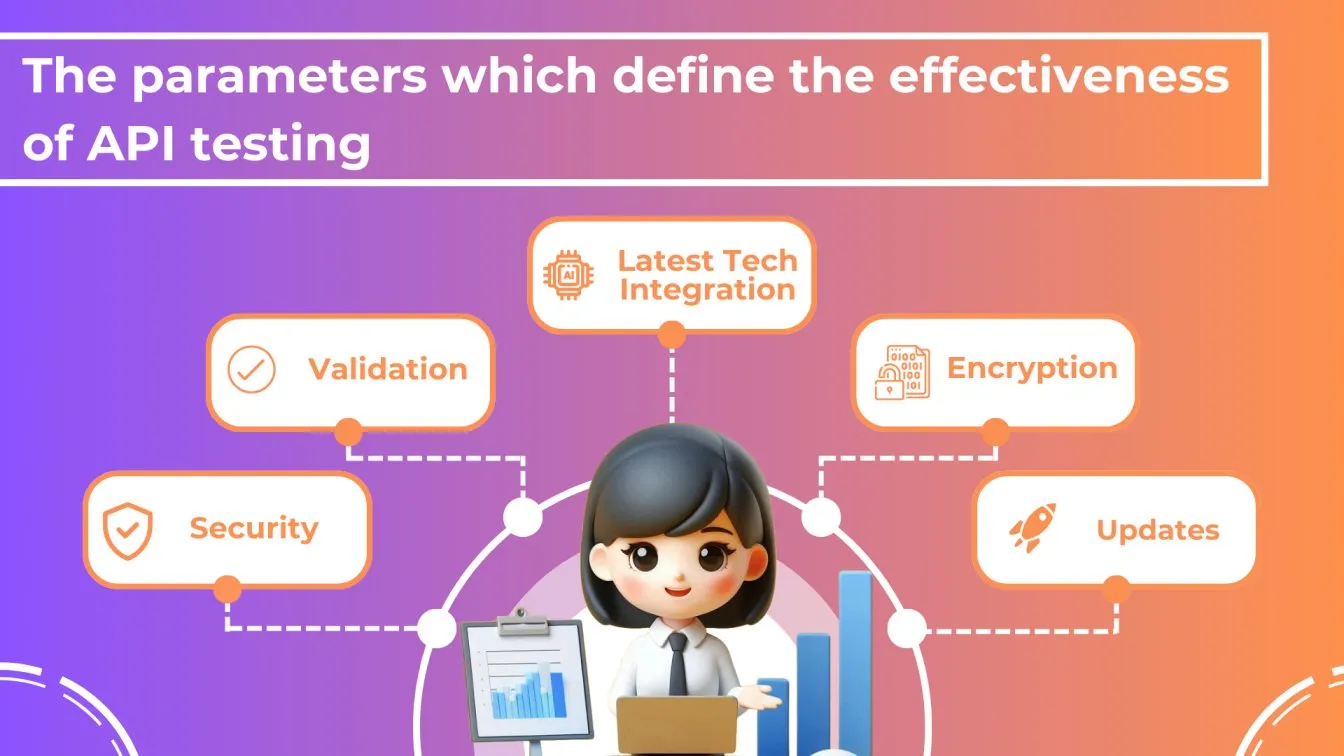
- Implement robust security measures like multi-factor authentication and encryption protocols to secure UPI transactions during API testing.
- Validate the transfer of funds and payment-related data securely to minimize the risk of fraudulent activities.
- Leverage technologies like blockchain to enhance the transparency of UPI and secure transactions.
- Adhere to best practices and conduct thorough testing to mitigate potential vulnerabilities and safeguard sensitive user information.
- Implement rigorous access controls and authorization mechanisms during API testing to prevent unauthorized access to funds.
- Encrypt details and implement secure communication protocols to protect user privacy and ensure the confidentiality of transaction information.
- Conduct regular updates and penetration testing to identify and address any security vulnerabilities or weaknesses in UPI transactions.
Exploring the role of UPI in Modern Payment Systems

Modern payment systems like mobile wallets, online credit/debit cards and digital currencies have changed how you pay for things. These sophisticated pieces of tech give you more choices while paying for offline or online shopping, electricity bills on time.
☀️ UPI offers a convenient and efficient payment experience for customers, enabling seamless transactions and instant money transfers between bank accounts.
☀️ Features such as facial recognition enhance security and streamline the authentication process for users, contributing to a frictionless experience.
☀️ Compatibility with various platforms ensures accessibility for users across different devices, including smartphones, tablets and computers.
☀️ The robust security 🔐 framework of UPI, including multi-factor authentication and encryption protocols, instillsq trust among users and businesses, making it a preferred choice for online transactions.
☀️ Banks and UPI applications collaborate to offer exclusive discounts and vouchers, incentivizing users to opt for UPI payments over cash transactions.
As UPI continues to evolve, it will likely introduce new features and technologies to further drive innovation in the fintech industry and shape the future.
UPI Payment vs Digital Currency - Role and Futures
In the digital landscape, UPI systems 📱 and digital currencies 💵 play distinct yet complementary roles. UPI, as a real-time payment platform, focuses on streamlining transactions within existing banking infrastructure, prioritizing efficiency and security. Conversely, digital currencies operate on decentralized networks, offering users autonomy and anonymity while challenging traditional banking models.
UPI and digital currencies represent different aspects of digital finance. For example, UPI focuses on enabling instant bank-to-bank transfers through mobile applications, while digital currencies like Bitcoin operate on decentralized blockchain networks, allowing peer-to-peer transactions without the need for intermediaries like banks.
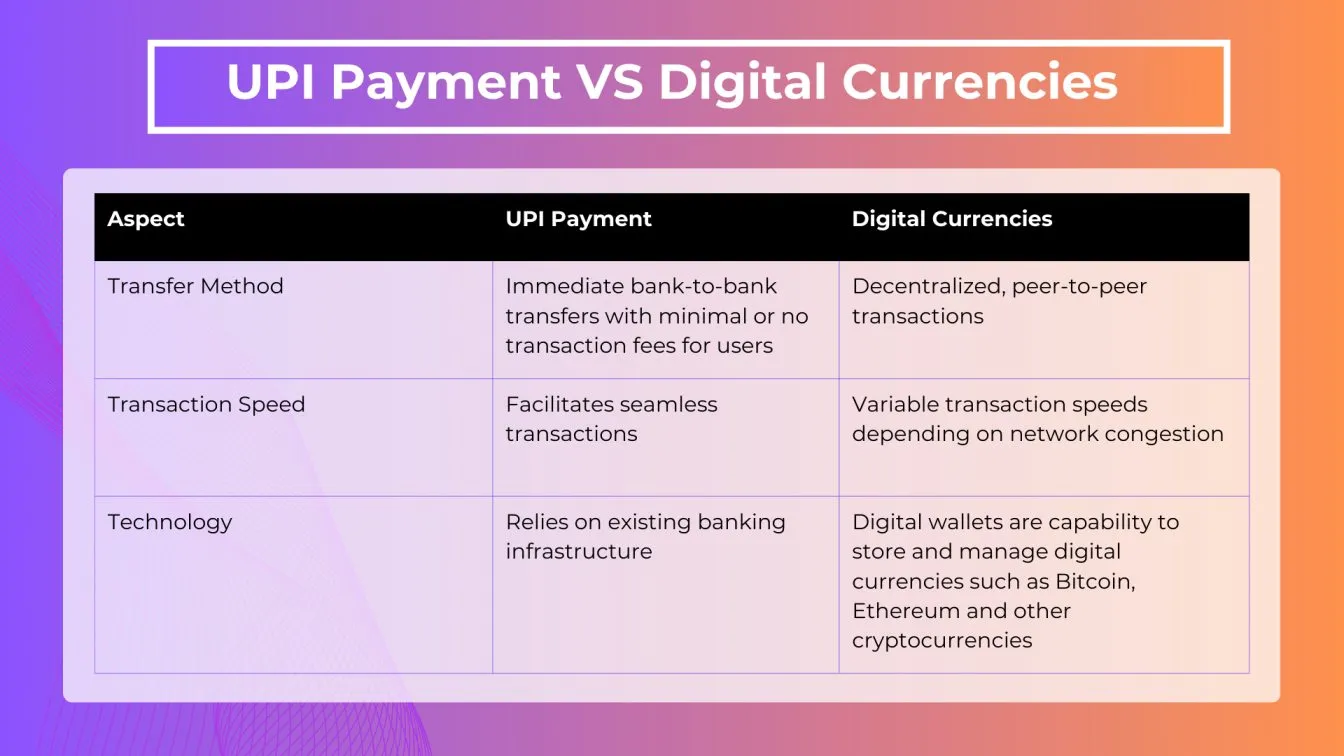
.webp)
Various phases of UPI API evaluation
Evaluating UPI APIs begins with the requirement analysis phase, where specific features and capabilities needed for UPI integration are identified.
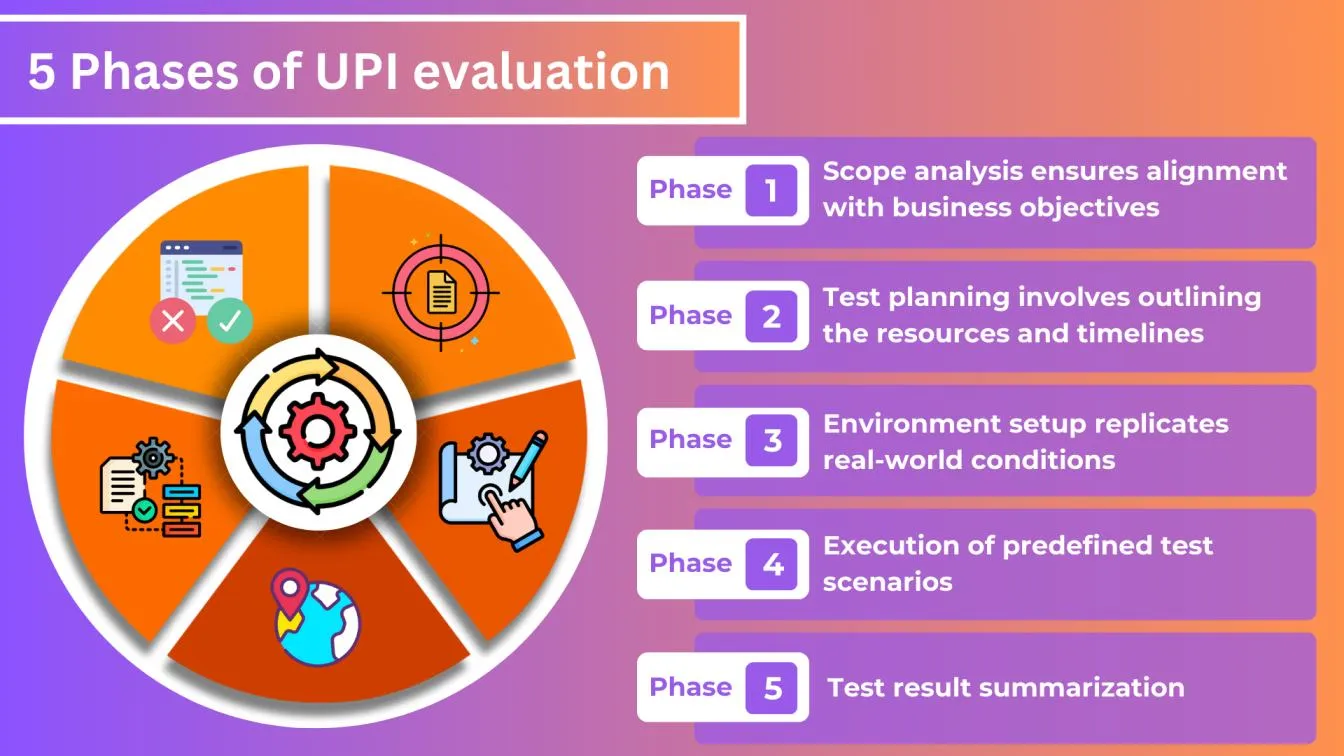
🚶Phase 1
This initial step is crucial for understanding the scope of testing and aligning it with business objectives and user requirements. Thorough analysis helps organizations to prioritize testing efforts and focus on critical areas.
🚴 Phase 2
Organizations outline the testing approach, resources and timelines required for UPI API evaluation. Test planning ensures that testing activities are organized, well-coordinated and executed efficiently. It includes defining test objectives, creating test plans and allocating resources such as testing tools and personnel.
🚗 Phase 3
Environment setup by configuring the testing environment to replicate real money conditions. This includes setting up various parameters such as different volumes of transactions, network configurations and system configurations. By mimicking real-world scenarios organizations can identify any potential issues that may arise in production environments.
✈️ Phase 4
Execution is the core phase where test cases are executed to validate UPI API functionality and performance. Testers run predefined test scenarios to simulate transactions and interactions with the API, ensuring seamless transactions and accurate transaction details.
🚀 Phase 5
The final phase involves summarizing test results and highlighting any issues or vulnerabilities discovered during testing. Test reports provide stakeholders with valuable insights into the quality and reliability of UPI APIs, enabling informed decision-making and prioritization of corrective actions.

The future of testing UPI APIs
The future of testing UPI APIs lies in adopting advanced technologies and adapting different payment preferences. Automated testing tools will play a significant role in enabling organizations to conduct comprehensive UPI payment testing quickly and reliably. Additionally, AI-driven testing solutions will provide insights into performance optimization and security enhancements.

Cloud-based banking software will become increasingly important, offering scalable infrastructure to handle large volumes of transactions and complex testing scenarios more effectively. This integration allows for real-time collaboration and continuous integration, ensuring seamless updates and improvements to APIs.
As UPI APIs continue to evolve, testing methodologies will evolve alongside, incorporating real-time payment System analytics and predictive modeling 🤖 to anticipate and address potential issues proactively. By embracing innovative testing approaches, including AI and cloud-based solutions will enhance API performance, security and user experience which lead to more reliable and efficient payment systems.
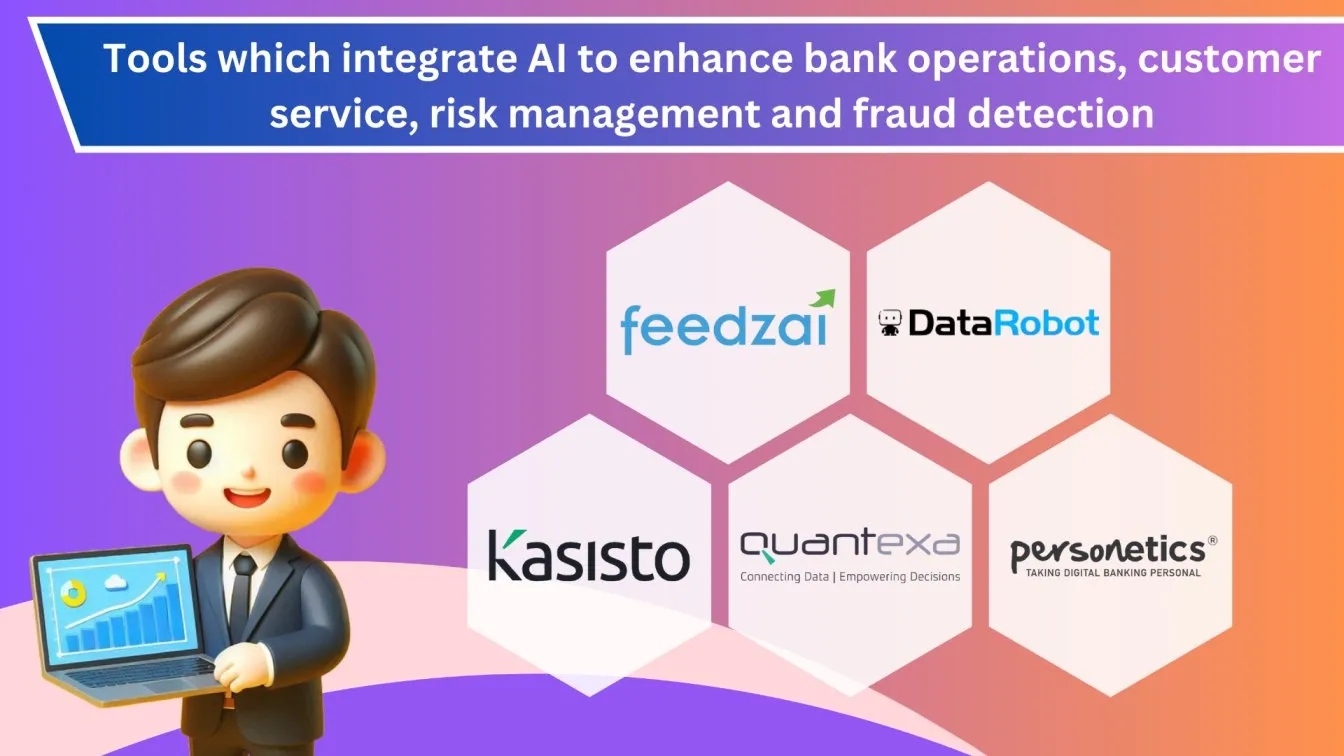
Some common pitfalls to avoid when testing UPI Payment system APIs
- Ensuring comprehensive test coverage is essential to avoid overlooking critical functionalities or edge cases during testing UPI Payment system APIs.
- Failing to conduct negative testing can lead to overlooking the system's resilience against unexpected inputs or errors, potentially compromising its integrity and security.
- Early identification and resolution of compatibility issues are crucial to prevent disruptions and ensure a seamless user experience when testing UPI Payment system APIs.
- Neglecting security testing leaves the system vulnerable to fraudulent activities or breaches, emphasizing the importance of addressing security concerns during the testing process.
- Addressing usability issues early in the testing process is vital to enhance user experience and prevent common challenges like lag and unresponsiveness.
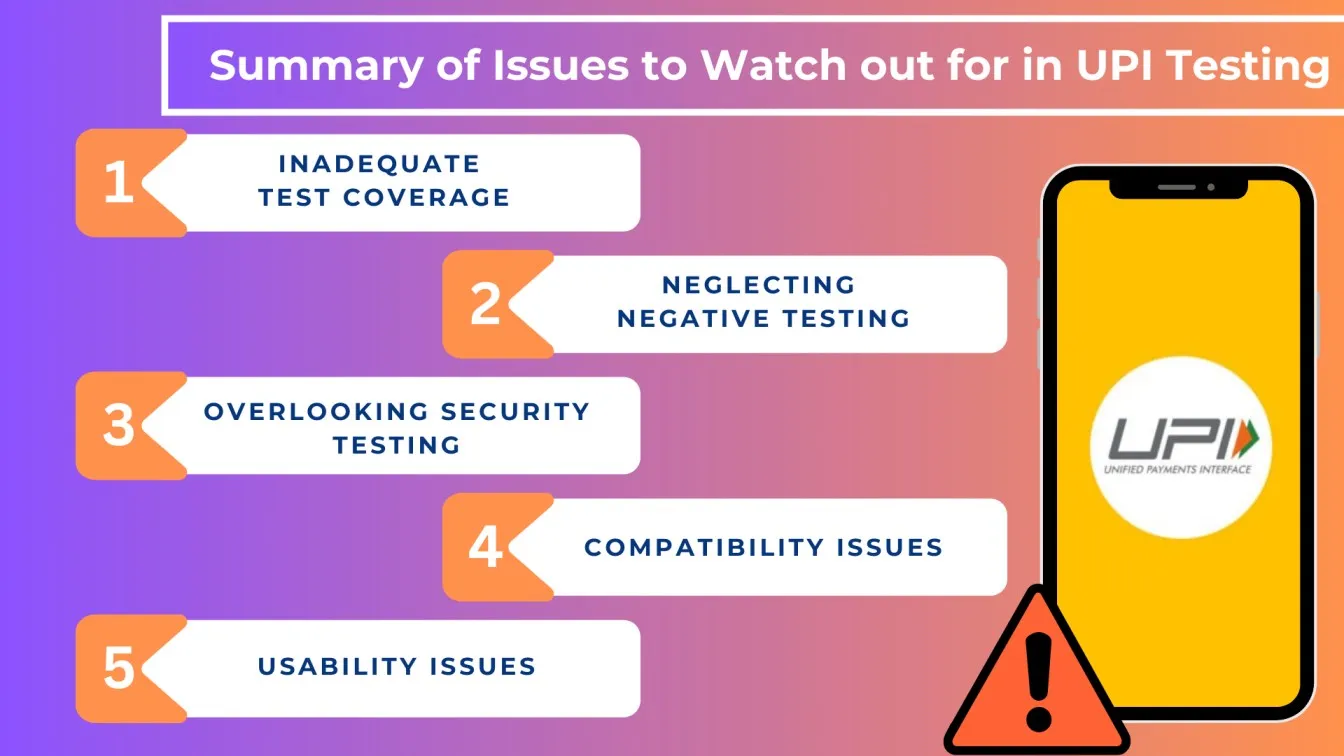
Wrapping Up!
Implementing best practices in API testing for UPI payment systems is crucial for ensuring reliable, secure, and efficient online transactions. Testing UPI payment APIs helps validate their functionality, performance, and resilience against various scenarios, using tools like Postman, SoapUI, JMeter, Selenium, and K6. Securing UPI transactions requires robust security measures.
UPI offers convenience, security, and cross-platform compatibility. When compared to digital currencies, UPI enhances traditional payment methods, while digital currencies aim to revolutionize financial ecosystems with blockchain technology.
Evaluating UPI APIs involves several phases to ensure a thorough assessment, considering factors like transaction processing time and volume. Future testing methodologies may incorporate advanced technologies to further improve efficiency and accuracy.

People also asked
👉 How to test payment APIs?
Testing payment APIs involves using tools like Postman or SoapUI to simulate transactions and meet specific business requirements, ensuring seamless integration with payment processors and service providers.
👉 Does UPI use API?
Yes, UPI relies on APIs to facilitate transactions between banks and user’s accounts. Payment service providers play a crucial role in ensuring smooth transaction processing.
👉 How to test payment gateway integration?
Integrating Testing payment gateway providers requires verifying transaction flows, error handling and security measures to meet business requirements and ensure compatibility with payment processors.
👉 What is the cost of UPI API?
The cost of UPI API usage varies depending on business requirements and transaction volume. The payment service providers offer flexible pricing plans tailored to meet different needs.
👉 What are the regulatory compliance requirements for UPI payment system API testing?
Regulatory compliance includes adhering to standards of PCI DSS (for International Payments), Federal Reserve System of US, etc. ensuring secure and compliant transactions for users and businesses.





%201.webp)

